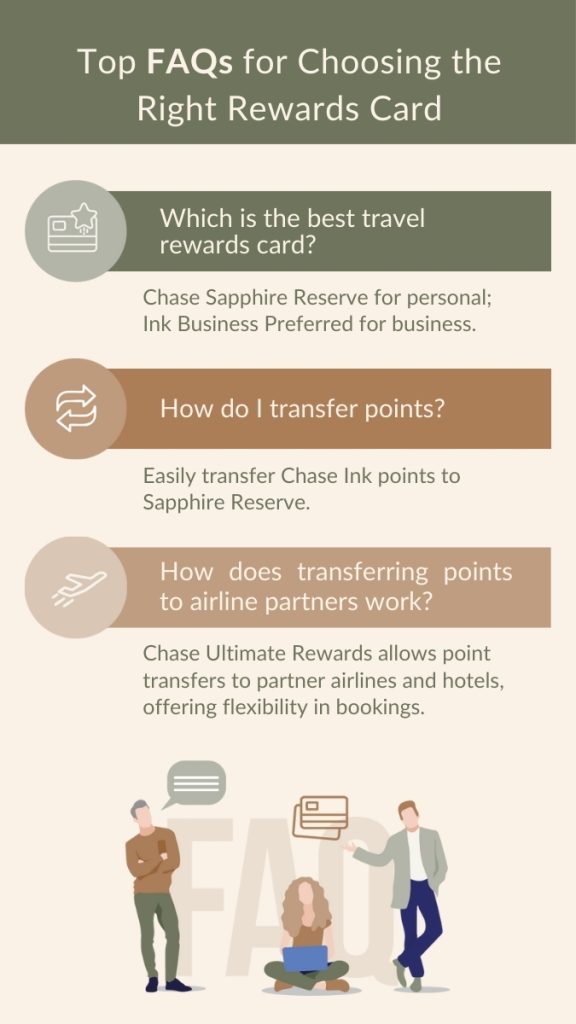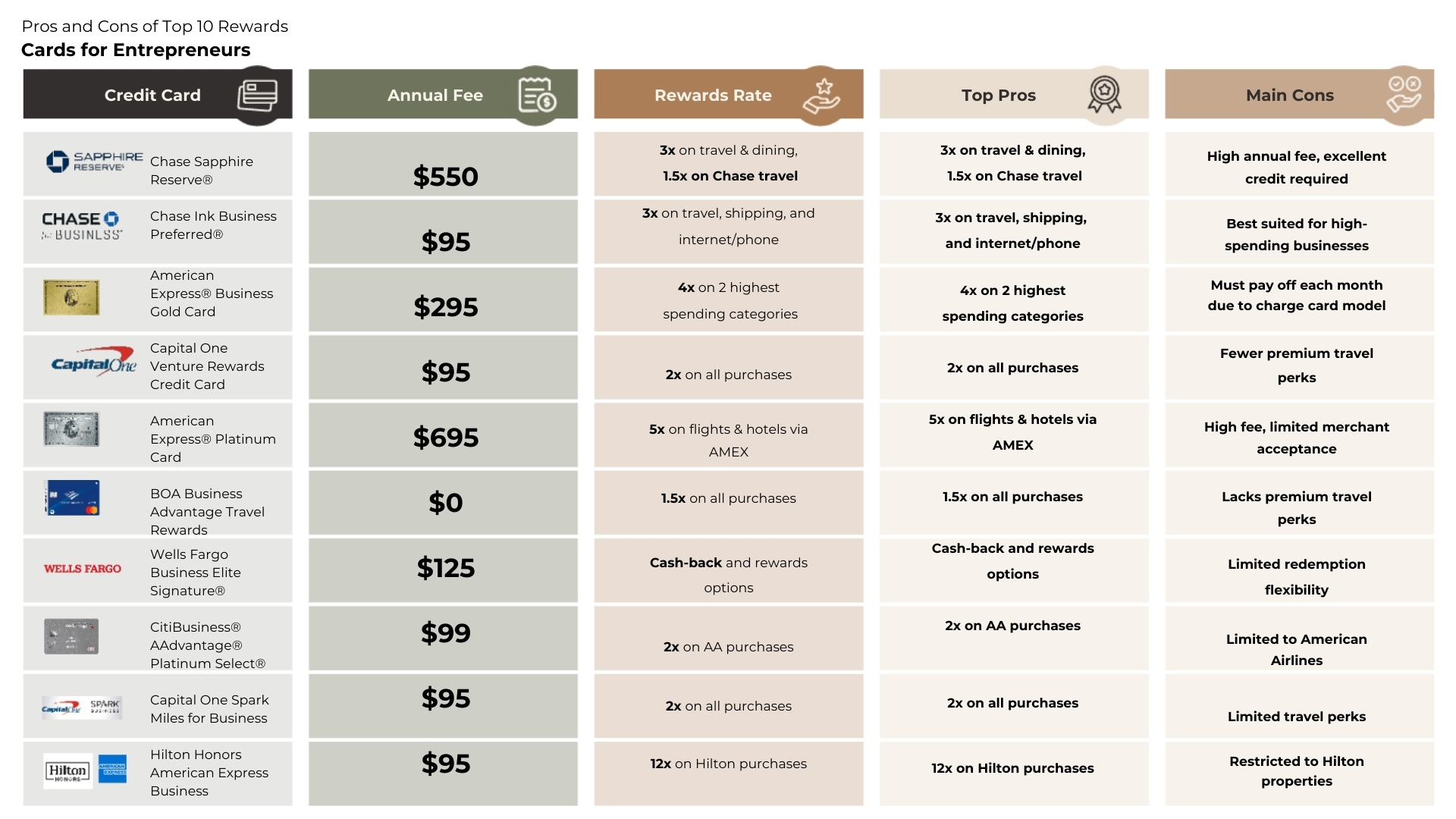
When you’re running a business, every expense is a chance to earn back value. From office supplies to client dinners and travel costs, the right credit card can turn these purchases into significant rewards. After years of using different cards, I’ve landed on the best options for 2024 for both personal and business rewards. Let’s break down the top contenders, how to maximize them, and a few tips on why I favor cards like Chase’s Sapphire Reserve and Ink Business Preferred for their transferability and travel perks.
Entrepreneurs are often road warriors, clocking miles both in the air and on the ground to expand their business reach. Travel rewards cards can reduce out-of-pocket travel costs, give access to premium airport lounges, and cover expenses like car rentals and hotel stays. In this guide, we’ll compare personal and business travel cards to show you how to earn the highest points per dollar and make the most of your rewards.

Personal Rewards Cards: Designed for flexibility, these cards are typically suited for entrepreneurs who want a high return on dining, travel, or everyday expenses. They often come with travel-centric perks, such as higher redemption rates when booking through their respective travel portals, travel credits, and lounge access.
Business Rewards Cards: For entrepreneurs with higher business expenses, these cards are optimized to reward specific categories like shipping, online advertising, and travel. Business rewards cards usually offer higher rewards rates in these categories, allowing you to accumulate points faster.
The Chase Sapphire Reserve remains one of my top choices for personal travel. Not only does it offer 3x points on travel and dining, but Chase Ultimate Rewards also boosts point value by 1.5x when booking through their portal.
With Chase Ink Business Preferred, you get 3x points on travel, shipping, advertising, and internet/phone services. I use this card across my businesses because the rewards can be transferred to my personal Sapphire Reserve account, maximizing the redemption value.
The AMEX Business Gold card’s strength is its flexibility with 4x points on two categories from a list of six, based on your highest spending areas each month.
The Capital One Venture card is simple and rewarding: earn 2x miles on every purchase with no complex categories.
The AMEX Platinum is a high-fee card, but the perks justify it for frequent travelers. With 5x points on flights and hotels booked through AMEX Travel and comprehensive travel perks, it’s a premium option.
The BOA Business Advantage is an excellent no-fee option for entrepreneurs who want simple, steady rewards.
This Wells Fargo card is unique with both cash-back and rewards options, a good fit for businesses needing flexibility.
Perfect for American Airlines loyalists, the CitiBusiness AAdvantage card focuses on mileage rewards and travel perks with AA.
The Capital One Spark Miles card is a solid option for business owners who want simplicity in earning 2x miles on every dollar spent.
The Hilton Honors Business Card is a strong contender for Hilton loyalists, with high points on Hilton purchases.

For years, I’ve used the Chase Sapphire Reserve and Chase Ink Business Preferred in combination. This setup allows me to rack up points quickly in both personal and business spending categories and then transfer those points for enhanced travel rewards. Let me break down how this strategy has kept flights, hotels, and even travel extras essentially free for my family vacations.

Primary Spending with Ink Business Preferred: Most of my business expenses go onto the Ink Business Preferred, earning 3x points on categories like travel, shipping, and advertising. For high-cost categories, this card maximizes returns on each dollar spent.
Transferring Points to Chase Sapphire Reserve: Once I’ve earned points, I transfer them to my personal Sapphire Reserve account, where they’re worth 1.5x when booking through the Chase portal. This boost has paid for entire family vacations, flights, and more—without draining personal funds.
Booking Flexibility: Chase Ultimate Rewards points can be transferred to various airline and hotel loyalty programs like United MileagePlus, Hyatt, and Marriott Bonvoy, allowing me to optimize bookings based on availability and point value.
Example Trip Using Points: On a recent family trip, I booked flights and a week-long hotel stay, covering $3,200 in costs entirely with points. Between the Reserve’s 1.5x boost and partner transfer options, our trip was fully covered without touching our personal bank account.
For entrepreneurs, the Chase Sapphire Reserve paired with the Ink Business Preferred gives high-value travel rewards. The Sapphire Reserve’s 1.5x redemption on travel through Chase makes it a standout.
By using a business credit card like Ink Business Preferred and transferring points to a personal card with higher travel perks (like the Sapphire Reserve), you can maximize point value across all purchases.
American Express offers premium services, such as extensive travel protections and concierge services, but charges merchants higher fees, which some businesses cannot justify.
Yes, if you travel often and use perks like lounge access and statement credits. For instance, the AMEX Platinum and Chase Sapphire Reserve offer credits that can offset these fees.
With Chase Ultimate Rewards, you can pool points from a business card like Ink Business Preferred to a personal Sapphire Reserve account, increasing points’ value by 50%.
The Bank of America Business Advantage Travel Rewards offers steady rewards with no annual fee, ideal for smaller businesses with moderate travel needs.
Charge cards, like many AMEX options, require full monthly payment. Credit cards allow balances to roll over but accrue interest if not paid in full.
The Capital One Venture and Spark Miles for Business offer easy redemption as travel statement credits or transfers to partners, making them highly flexible.
Some credit cards, like those with Chase Ultimate Rewards, allow you to transfer points to travel partners (e.g., United or Hyatt), offering flexibility to book flights or hotels directly with the partner.
If the card is under a business EIN and kept in good standing, it typically doesn’t impact your personal credit, though any missed payments may be reported on personal credit.
With these options in hand, you can find the right mix of personal and business rewards cards to suit your spending patterns and travel goals. Whether you’re looking to cover travel expenses, access exclusive lounges, or simply streamline rewards, this guide should make the decision-making process a lot easier.
Disclaimer: The information provided in this article reflects the credit card offers, fees, and terms available at the time of writing. However, credit card companies frequently update their terms, rewards structures, and annual fees. We recommend checking directly with the issuing bank for the latest information. We apologize for any discrepancies between our content and the current terms as specified by the banks.